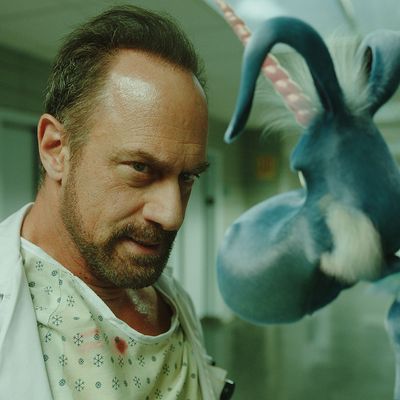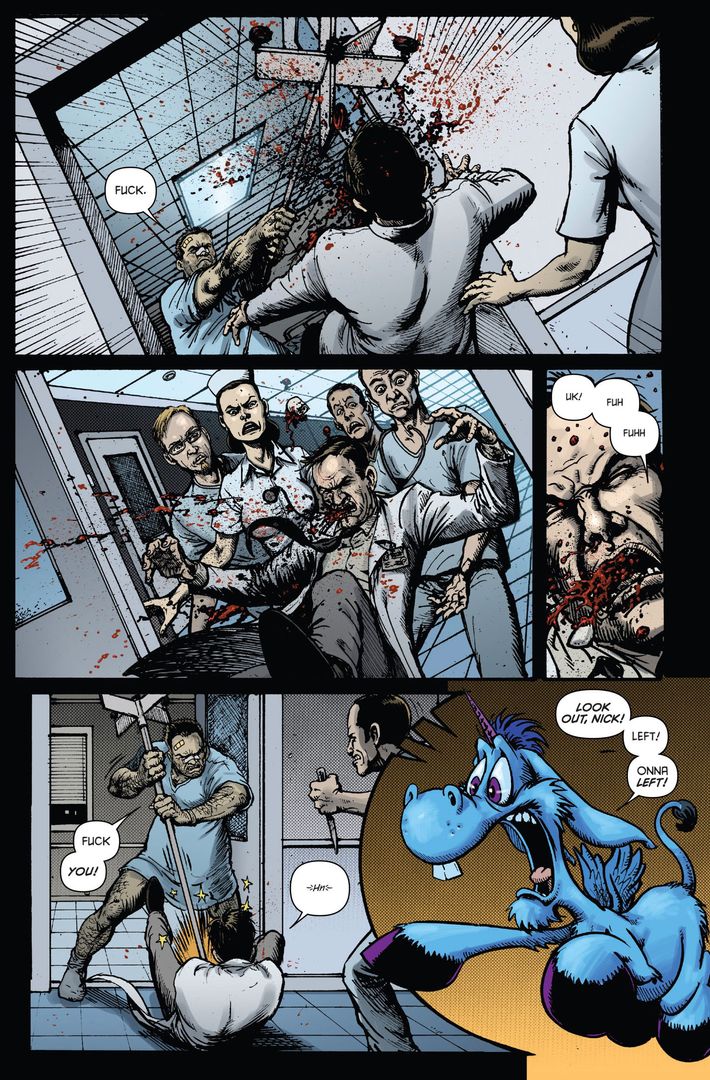
Christopher Meloni is ready to fight Santa Claus. ÔÇ£I got a cortisone shot,ÔÇØ the actor bellows, tapping a shoulder thatÔÇÖs been giving him trouble, ÔÇ£so by Friday, I think IÔÇÖll be able to kick SantaÔÇÖs ass!ÔÇØ ItÔÇÖs a gorgeous fall day in BrooklynÔÇÖs Green-Wood Cemetery, and Meloni is about to shoot a graveside scene for his new TV series Happy! (exclamation point mandatory). But not long after that, heÔÇÖll face down a child-kidnapping, drug-addicted Saint Nick impersonator. ItÔÇÖs maybe the 23rd weirdest thing that happens on the show.
Happy!, which debuts on SyFy on December 6, is a phantasmagoria of bloodied corpses and imaginary friends, near-death experiences and lysergic hallucinations, costumed sex criminals and torture artists in medical scrubs. At its center is MeloniÔÇÖs Nick Sax, a cop turned hit man who may or may not be immortal and in communication with a flying anthropomorphic unicorn named Happy. The show opens with a sequence in which Nick spits blood into a urinal, shoots himself in the head with two guns, then grooves alongside some go-go dancers to a disco version of ÔÇ£Jingle BellsÔÇØ while a fountain of blood erupts from his skull ÔÇö and it only gets more profane and insane after that. In the age of Peak TV, Happy! has set out on a mission to capture distracted eyeballs at all costs.
ÔÇ£Look, thereÔÇÖs a thousand TV shows out there,ÔÇØ says the showÔÇÖs co-creator, Brian Taylor, surveying the graveyard scene a few yards away from his star. ÔÇ£ThereÔÇÖs never been more media, so if youÔÇÖre gonna do something, youÔÇÖve gotta try to make it special. We just want to make it be like, ÔÇÿWow, IÔÇÖve never seen that show before.ÔÇÖÔÇØ
Happy! has a leg up in that effort thanks to the viciously idiosyncratic nature of its source material. The program is based on an adults-only, four-issue comic book of the same name, originally released in 2012 and 2013. The creative pedigree was high: Happy! was drawn by Darick Robertson and written by a well-mannered Scottish eccentric named Grant Morrison. The former is best known for his work on a famously obscene series called Transmetropolitan and the latter has too many geek credentials to list here. In addition to being the scribe behind acclaimed comics runs with family-friendly characters like the X-Men and Batman, Morrison has a reputation for coming up with profoundly unsettling and graphic stories with titles like The Filth and Annihilator. (HeÔÇÖs also written eloquently about practicing literal magic and communing with nonhuman intelligences in Kathmandu.)
Morrison planted the first seeds of Happy! while watching one of the grimmer indictments of the 21st century: American Idol. ÔÇ£Simon Cowell was doing his usual thing,ÔÇØ he tells me in his lilting brogue, ÔÇ£insulting a bunch of young kids who were up there trying to sing and dance and do their very best, and then having to face this withering onslaught of cynical criticism.ÔÇØ Morrison saw the degradation as part of a larger societal pattern. ÔÇ£That sort of thing was also playing out on the internet as well, where anyone who opens their mouth is subject to the same kind of barrage of cynicism. So it just seemed like an interesting thing to dramatize, this push and pull between cynicism and hope, and between optimism and pessimism.ÔÇØ
Morrison opted to personify those polar opposites in the form of ÔÇ£the ultimate degenerate ex-copÔÇØ and ÔÇ£a bizarre little imaginary creature who is relentlessly upbeat and positive and, to be honest, sometimes quite irritating and annoying.ÔÇØ He reached out to Robertson, an artist with whom heÔÇÖd wanted to work, and who was quickly jazzed by the idea. Robertson consulted the art of the late, legendary comics creator Will Eisner for inspiration on how to build the storyÔÇÖs dreary New York setting and aimed to evoke what he calls ÔÇ£that ÔÇÿlonely guy drinking on ChristmasÔÇÖ dive-bar vibe, like a twisted Tom Waits song.ÔÇØ Et voil├á, Nick Sax and his cartoonish unicorn companion Happy were born.

Their adventure in the comic-book series was a densely surreal one, but hereÔÇÖs the basic gist: Mobsters are out to get Nick because they believe he has information they need. After Nick almost dies, Happy appears to him and urges him to go on a mission to save a little girl named Hailey. Only Nick can see Happy, who claims to be the girlÔÇÖs imaginary friend, and the two of them go on the run from the mafiosi; after initial reluctance, Nick agrees to also seek out Hailey. Nick hates everything, Happy loves everything, and they gradually reach a d├®tente about the nature of the world. But at first blush, the plot takes a back seat to the operatic vulgarity and violence.
The tone was set on the very first page, in which some mobsters walk along a snowy New York street at Christmastime and discuss Nick, whom they have been hired to murder. ÔÇ£So how come it takes four guys to kill one lone prick?ÔÇØ one asks. Another replies, ÔÇ£A prick? Nah. Let me tell you something about the man weÔÇÖre here to kill. Nick Sax is a cunt.ÔÇØ ÔÇ£A cunt?ÔÇØ his buddy asks. ÔÇ£You know, like some men are pussies. Some are dicks, or assholes. Nick Sax is a professional cast-iron cunt.ÔÇØ In the final panel, Robertson depicts a different man expelling a waterfall of vomit while a small stray dog pees on him. Two pages later, a man dressed as a crustacean gets shot in the skull while receiving a blow job. Later, a sadistic mob contractor waxes poetic about how Nick will be ÔÇ£having salami slices cut from his penis.ÔÇØ Heads are blown off, drugs are injected, and pedophiles are executed. Merry Christmas.
Morrison says he had to push himself to be so over the top. ÔÇ£My head tends more towards gee-whiz sci-fi and psychedelia,ÔÇØ he says. ÔÇ£For me, it was going into very different territory and seeing what I could do with it. But fortunately, I come from Scotland, where people swear constantly and swearing is used as punctuation. I love swearing. I think swearing is one of the great pleasures of the articulate man and woman.ÔÇØ The series, published by the famously permissive Image Comics, earned mixed reviews. On one hand: ÔÇ£The book is funny, smart, quick, different and absolutely beautiful,ÔÇØ wrote Bleeding CoolÔÇÖs Rich Johnston. On the other: ÔÇ£IÔÇÖm a huge Grant Morrison fan, but I was ready to quit Happy! halfway through the first issue,ÔÇØ wrote PasteÔÇÖs Garrett Martin.
Whatever the critical response, Morrison was proud enough of the work that he saw a future for it beyond the comics page. He didnÔÇÖt anticipate that it would be easy. ÔÇ£IÔÇÖd been trying to sell stuff in Hollywood for years and years, and even though I managed to sell a few scripts, nothing was ever produced,ÔÇØ he recalls. ÔÇ£But with Happy!, itÔÇÖs been a clear line straight through.ÔÇØ That line began with a pitch to Taylor, who had earned a cult following for writing and directing the kabonkers action flicks Crank and Crank: High Voltage alongside Mark Neveldine. Those films are wild almost beyond description, centering around the adventures of an outlaw played by Jason Statham who has to stave off death by keeping his heart rate elevated in the first one and by repeatedly charging himself with electricity in the second. The Crank movies are awe-inspiringly offensive, deliriously ambitious, and they found a fan in Morrison.
The Scotsman and Taylor met long before Happy!ÔÇÖs development and, in TaylorÔÇÖs recollection, Morrison told him he was particularly enamored of High Voltage. ÔÇ£ThereÔÇÖs 99 percent of the world that hates the Crank movies,ÔÇØ Taylor says, ÔÇ£but of the one percent that likes them, thereÔÇÖs the Crank ones and then thereÔÇÖs the Crank 2 people. And the Crank 2 people? ThatÔÇÖs my people.ÔÇØ When Taylor was approached with the idea of adapting Happy!, he jumped at it. Morrison signed on as an executive producer, they co-wrote the pilot, SyFy picked it up, Meloni was cast, Taylor directed, and it went to series.
In the show, Meloni synthesizes two polar-opposite breeds of character heÔÇÖs known for playing: the determined enforcer in Law & Order: SVU, and the comedic madman he so deftly embodies in Wet Hot American Summer. Nick is at once cold-blooded and sympathetic, frightening and mirthful ÔÇö and heÔÇÖs as much a product of Meloni as he is of Morrison or Taylor, in that Meloni gets a long leash to revise lines on the fly. To wit: At the cemetery, when a character suggests that Nick move to California, the script called for him to reply, ÔÇ£Give up all this grime, grit, and grousing? Nah. Besides, New YorkÔÇÖs got the best holes to crawl out of every other weekend.ÔÇØ Meloni opted for pith instead: ÔÇ£California? Not my kind of dirty. Plus, I hate quinoa.ÔÇØ
He also had to rise to the challenge of sharing scenes with empty air that would later be filled by a CGI unicorn. SNLÔÇÖs Bobby Moynihan was originally cast as Happy and voiced him in the original pilot, but he was replaced with comedian-actor Patton Oswalt for the series. A die-hard geek, Oswalt had been a fan of both the original Happy! and the Crank series ÔÇö he calls Taylor ÔÇ£our Takashi Miike,ÔÇØ referring to the audacious Japanese auteur ÔÇö so signing on was a no-brainer. He agrees with TaylorÔÇÖs claim that the show aims to break through the crowded TV landscape, and thinks it does so by tuning its thrills to a perfect pitch. ÔÇ£ItÔÇÖs popcorn entertainment, if the popcorn was the most artisanally grown corn kernels, cooked in the rarest olive oil in the most gorgeous copper pan,ÔÇØ Oswalt says. ÔÇ£ItÔÇÖs the top shelf of junk food.ÔÇØ
The cast and crew take a certain degree of pride in how horrific their show can be and how close to the edge Taylor has pushed them. They also spoke in hushed tones about the showÔÇÖs seventh episode, which none of them would actually describe to me. ÔÇ£I canÔÇÖt say anything other than when you watch it, youÔÇÖll know exactly what IÔÇÖm referring to,ÔÇØ says Twin Peaks: The Return and Mad Men alum Patrick Fischler, who plays a torturer named Smoothie. As Fischler puts it, ÔÇ£Brian keeps trying to get me to say, ÔÇÿI canÔÇÖt do that,ÔÇÖ and guess what? IÔÇÖve never said it.ÔÇØ
That said, everyone involved in Happy! hastens to make clear that theyÔÇÖre aiming beyond pure shock or escapism. ÔÇ£To say that itÔÇÖs part of the Zeitgeist is true,ÔÇØ showrunner Patrick Macmanus says. ÔÇ£ThereÔÇÖs a certain cynicism to Sax that has unfortunately taken root in the country, in the world, and in at least a healthy segment of our population. Happy represents the side of us that feels from time to time that is dying.ÔÇØ The idea here, in between all the visions of gonzo carnage, is to talk about that dichotomy. ÔÇ£I really love the journey of Sax and Happy, where they take a little bit from each other. Happy becomes a little bit more worldly and Sax becomes a little bit more optimistic and forward-thinking.ÔÇØ In other words, Morrison is finally getting his revenge on Simon Cowell.
Of course, no one wants to make Happy! sappy. As Taylor stands in the dappled light of Green-Wood Cemetery, I ask what he wants audiences to say to themselves after they see the show. He pauses for a second, but only a second, and voices his hoped-for response: ÔÇ£What the fuck did I just see?ÔÇØ

